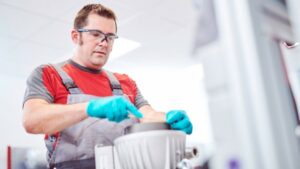Technical tradition Like many crafts, glassmaking requires knowledge and knowhow based on oral tradition. (Courtesy: iStock/bill oxford)” width=”635″ height=”423″>
Handmade is a very personal book. For author and materials scientist Anna Ploszajski, a myriad of materials are connected to different times and events in her life. For her, brass is linked with her learning the trumpet, paper with sex education in secondary school, and glass with the start of her studies at the University of Oxford. Plastic is connected with her grandfather’s arduous immigration to the UK, steel with an adventurous trip to Nevada as part of a racing team, clay with being bullied by one of her supervisors. Sugar reminds her of swimming the English Channel, wood with her grandparent’s garden, stone with her fear of heights, and wool with a road trip through the UK.
Indeed, Handmade: a Scientist’s Search for Meaning through Making could have been titled “My life in 10 materials”. As a reader, I found this connection charming, and it really shows that we live in a material world.
Ploszajski attempts to discover how all the materials we come across in our daily lives are made, and how they work. Each chapter in the book follows a similar structure. They start out with a personal story, tell the history of the material in question, and then there is a little bit of science and making. The strength of the book is the personal touch and the history of the material. The science itself makes for very light reading – while the information is accurate, it barely scratches the surface. Ploszajski also does not include any further references to detailed sources that the reader may choose to explore later. So perhaps Handmade is aimed at a very general audience, rather than those already in the sciences. I couldn’t help feeling that, despite my curiosity being awakened, it was not assuaged by the book, which is perhaps a missed chance.
Where I felt the book was lacking, despite its subtitle, was in the “making” element of the stories. When I was asked to review this work, I was excited. As a physicist in a School for Art and Design working with expert craftspeople every day, I have learned to respect and value the tacit knowledge of my colleagues. Coming from science and the tradition of academic recording of intellectual knowledge, it is not easy to recognize the wealth of craft-based knowledge and knowhow, which has an oral tradition and is handed down from expert to student. A lot of it is now endangered because there is not yet a system in place to record the skill sets connected to different craft activities.
Ploszajski approaches making with the attitude of an academic scientist: if the theory is understood, the making is just an add-on. In the chapter about glass she spends half a day at Chem Glassware. No further information is given about the company, which is regrettable. The production of chemical glassware is a minute subsection of glassmaking, with its own technicalities. It shows one aspect of what can be done with glass. Spending half a day trying to manipulate glass is not making anything, as it takes years of practice to understand and excel at the craft.
Spending half a day trying to manipulate glass is not making anything, as it takes years of practice to understand and excel at the craft
I was hoping to find a discussion of the connection between this kind of knowledge and the physical and chemical properties of glass, bridging between tacit and intellectual knowledge. Instead, the author has neither acquired new skills nor gained new understanding but feels her image of glass confirmed. It could also have been a good springboard to launch into the more exotic types of glass, which we unfortunately don’t hear about.
Another material close to my heart is paper, the subject of another chapter. Most prints are still done on paper. It is of paramount importance to understand paper whether one is an artist or an industrial printmaker. The paper substrate will determine how long the print will last, how it can be recycled, how the colour will appear and how it will “feel”. Ploszajski discusses paper for books, without going deeper.
Maybe instead of trying to make some paper, printing would have given her more insight into the interaction of ink and paper – for example how much appearance is changed just by choosing a different type of paper for a print. She mentions the problem of acid paper and its self-destruction when stored, but does not discuss how different publications demand different types of paper. There is a huge difference between the paper for a free newspaper, which will not last longer than a day and needs to be recycled, and a high-end photographic publication or an artist book that will be kept in a collection for the next 100 years or longer. Ploszajski does not mention the increasing importance of paper for the packaging industry. Maybe the paperback book will disappear into screen-based reading, but with the negative impact of plastic on the environment, paper will regain its importance in packaging.
Despite my grievances, the book is a pleasant read. While Ploszajski may not be much of a maker, she is a good storyteller. Ultimately, Handmade has demonstrated to me how difficult it is to appreciate in a balanced way two of the major forces that change the world: science and craft.
- 2021 Bloomsbury £17.99hb













